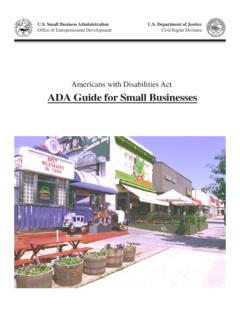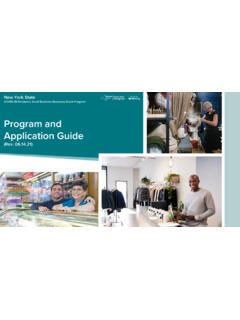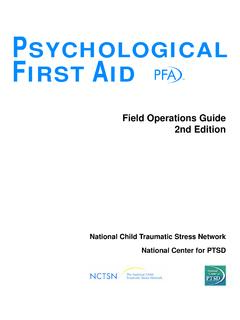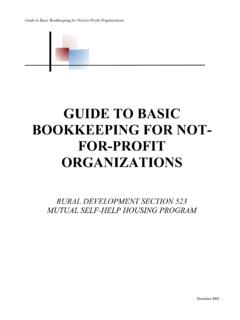Transcription of Supporting Organizations Guide Sheet Explanation
1 Supporting Organizations Guide Sheet Explanation Type I and Type II March 13, 2008 This Guide Sheet Explanation is designed to provide an overview of exempt organization tax law rules applicable to Supporting Organizations and to assist in preparation of the IRC 509(a)(3) Supporting Organizations Guide Sheet Type I and Type II. A separate Explanation and Guide Sheet is available Type III Supporting Organizations . OVERVIEW Background Every organization described in IRC 501(c)(3) is further classified under IRC 509(a) as either 1) a private foundation, or 2) other than a private foundation if it qualifies under IRC 509(a)(1), (2), (3), or (4). Private foundations typically have a single major source of funding (usually gifts from one family or corporation rather than funding from many sources).
2 Organizations that are qualified under IRC 509(a)(1) include churches, hospitals, qualified medical research Organizations affiliated with hospitals, schools, colleges and universities, and Organizations that have an active program of fundraising and receive contributions from many sources, including the general public, governmental agencies, corporations, private foundations or other public charities. Organizations qualified under IRC 509(a)(2) receive income from the conduct of activities in furtherance of the organization s exempt purposes. Organizations qualified under IRC 509(a)(3) actively function in a Supporting relationship to one or more IRC 509(a)(1) or (2) Organizations . An organization may request IRC 509(a)(3) status either 1) when it initially files a Form 1023 application for IRC 501(c)(3) exemption, or 2) subsequently, by requesting a determination letter that changes its existing foundation status.
3 A nonexempt charitable trust described in IRC 4947(a)(1) may also request a determination that it is described in IRC 509(a)(3), even though it is has not been recognized as an IRC 501(c)(3) organization , pursuant to Revenue Procedure 72-50, 1972-2 830. For information about Rev. Proc. 72-50, see FY 1980 Continuing Professional Education text entitled General Explanation of Trusts Subject to Section 4947 of the Internal Revenue Code. The Pension Protection Act of 2006 (PPA of 2006) modified the statutory scheme applicable to Supporting Organizations to address concerns that some Supporting Organizations were being used to inappropriately benefit private interests. This Guide Sheet inquires about Supporting organization arrangements that lend themselves to private benefit abuses, including situations where a Supporting organization makes loans, grants, or compensation payments to or for the benefit of donors or donors families and businesses.
4 The Guide Sheet also inquires about situations where the Supporting organization is a recipient of closely held stock, personal residences, partnership interests, 2sole proprietorships, or insurance policies, as these asset types may be manipulated for the benefit of donors or donors families and businesses. In these circumstances, one needs to consider possible denial of IRC 501(c)(3) exemption, or possible denial of IRC 509(a)(3) Supporting organization status. Types In general, Supporting Organizations have been identified by the type of relationship they have with their supported IRC 509(a)(1) or (2) Organizations . Under the PPA of 2006, Supporting Organizations are classified into Type I, Type II, or Type III Supporting Organizations . The names are new, but they merely reflect the existing three relationships with supported Organizations described in the current regulations.
5 Type I Supporting Organizations are operated, supervised, or controlled by one or more IRC 509(a)(1) or (2) Organizations . Type II Supporting Organizations are supervised or controlled in connection with one or more IRC 509(a)(1) or (2) Organizations . Type III Supporting Organizations are operated in connection with one or more IRC 509(a)(1) or (2) Organizations . The PPA of 2006 classifies Type III Supporting Organizations into the following two categories: Type III Supporting Organizations that are not functionally integrated or functionally integrated Type III Supporting Organizations . Type III Supporting Organizations that are not functionally integrated are subject to excess business holding rules under IRC 4943 and must meet annual payout requirements.
6 Further, private foundations are prohibited from treating grants made to Type III Supporting Organizations that are not functionally integrated as qualifying distributions under IRC 4942. Functionally integrated Type III Supporting Organizations are not subject to excess business holding rules of IRC 4943, are not subject to annual payout requirements, and private foundations may treat grants to functionally integrated Type III Supporting Organizations as qualifying distributions under IRC 4942. Until final guidance is issued that defines functionally integrated Type III Supporting Organizations as described in IRC 509(d) and 4943(f)(5)(B), the IRS is generally suspending the issuance of determination letters to this category of Type III Organizations other than Organizations that choose to meet the advance notice of proposed rulemaking.
7 [See Advance Notice of Proposed Rulemaking (ANPRM), 72 Fed. Reg. 42335 (Aug. 2, 2007). This ANPRM is available from the IRS website at under Charities and Nonprofits.] The ANPRM sets forth criteria for qualifying as a functionally integrated Type III Supporting organization . If a Type III Supporting organization chooses to meet the ANPRM, IRS may issue a determination letter that classifies it as a functionally integrated Type III Supporting organization . Of course, the organization would have to comply with the regulations that define functionally integrated Type III Supporting Organizations when they are finalized. If an organization chooses not to agree to comply with the ANPRM, it can qualify for a determination letter that classifies it as a Type III 3supporting organization without determining whether it is or is not functionally integrated.
8 In this case, Notice 2006-109, 2006-51 1121, provides rules on which private foundations can rely to ensure they are not making grants to Type III Supporting Organizations that are not functionally integrated. Finally, Announcement 2006-93, 2006-48 , provides for an expedited process whereby Organizations that are classified as IRC 509(a)(3) Supporting Organizations may, if they qualify for the status, obtain a determination letter that modifies their foundation classification to IRC 509(a)(1) or (2). A Supporting organization must meet an organizational test that requires it to contain provisions in its organizational document ( articles of incorporation, trust instrument, articles of association, or articles of organization ) that limit its purposes to operate exclusively for the benefit of, to perform the functions of, or to carry out the purposes of one or more IRC 509(a)(1) or (2) Organizations .
9 A Supporting organization must also meet an operational test that requires it to engage solely in activities that support one or more publicly supported Organizations . A Supporting organization may not be controlled directly or indirectly by a disqualified person. Effective August 17, 2006 the PPA of 2006 provides that neither a Type I nor Type III Supporting organization qualifies as a Supporting organization if it accepts gifts from a person (other than a IRC 509(a)(1), (2), or (4) organization ) that directly or indirectly controls (alone, or together with family members and 35 percent controlled Organizations ) the governing body of a supported organization . A Type I Supporting organization must be operated, supervised, or controlled by one or more publicly supported Organizations .
10 The relationship between the supported organization and the Supporting organization is like a parent-subsidiary relationship. This relationship exists where one or more supported Organizations (by their governing bodies, members of the governing bodies, officers acting in their official capacities, or their membership) elect or appoint a majority of the organization s officers, directors, or trustees. A Type II Supporting organization must be supervised or controlled in connection with one or more publicly supported Organizations . A Type II relationship is like a brother sister relationship. In a Type II relationship, the same persons control or manage both the Supporting organization and the supported organization . SPECIFIC Explanation KEYED TO Guide Sheet PART I: ORGANIZATIONAL TEST UNDER IRC 509(a)(3)(A) An organization must meet the organizational test to qualify under IRC 509(a)(3).


















